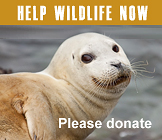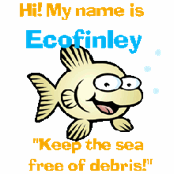harbor porpoise
Harbor porpoise necropsied today
May/17/17 06:57 AM
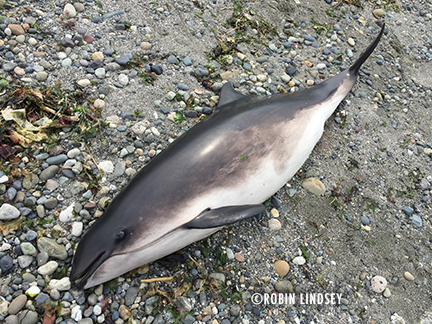
Brand new Seal Sitters (SSMMSN) volunteer Judy, trained this past Saturday, was out for a hike near West Seattle’s lighthouse yesterday afternoon when she came across a fresh-dead harbor porpoise on the pebbled beach. Having just learned that SSMMSN responds to reports of all marine mammals, dead and alive, she contacted the proper authorities and SS First Responder Lynn arrived on scene, shortly after our hotline @ 206-905-SEAL (7325) received the report.
Cascadia Research Collective was immediately called and confirmed they wanted the porpoise for necropsy. First Responders Robin, David and Ralph arrived and photos were texted to Jessie Huggins, stranding coordinator for Cascadia. Based on initial review of photos sent by Seal Sitters, it appears the adult female is either pregnant or recently gave birth. Plans were set in motion for biologist Erin Keene and a former intern to drive a truck up from Tacoma to collect the perfect specimen.
With the help of several members of the public (also environmental stewards), the approximately 125-150 lb porpoise was rolled onto a tarp, carried off the beach and up into a private driveway, where she was picked up by the Cascadia team shortly after 6pm. Thanks so much to homeowner Margaret who allowed us access thru her property, making the transfer off the beach much shorter and kudos to those who helped carry the heavy porpoise.
The stunning porpoise showed no obvious injuries, aside from nicks on flippers. Possible predation by transient orcas is always a concern, especially with the recent heightened transient presence in Central and South Puget Sound, and internal hemorrhaging from such an attack could still be present (often times, prey is rammed and not consumed). However, it seemed more likely that cause of death was related to pregnancy complications or disease.
In the Pacific Northwest’s Salish Sea, harbor porpoise calving typically occurs in the summer months. On May 1, 2013, SSMMSN responded to a dead neonate on the shoreline along Beach Drive. Harbor porpoise numbers have greatly rebounded in Puget Sound, after nearly disappearing in the 1970s. Cascadia and WDFW Marine Mammal Investigations collaborated on a study of 20 year aerial surveys of Washington waters. Read more about the species’ return in this recent paper. An additional resource can be viewed here on NOAA’s website.
NECROPSY RESULTS
The necropsy was performed by Cascadia today. The female was indeed pregnant, but probably a month or two away from full term. There was no trauma or evidence of pregnancy complications, but an underlying disease that may have caused early termination of pregnancy can’t be ruled out. Neurological disease is suspected and will be further evaluated histologically. A moderate lungworm infection was found, which is fairly typical for this particular species, but can also be a symptom of a more significant disease process.
Juvenile harbor porpoise strands on private beach
May/01/13 07:03 PM
Seal Sitters responded this afternoon to a call about a dead harbor porpoise on private property near the Alki Lighthouse. The juvenile male, estimated to be between 2-3 years old, was an intact, fresh specimen and was taken for necropsy by Jessie Huggins of Cascadia Research. The animal was somewhat thin and had some lacerations on the tail. Thanks to Jessie for giving our responders an on-the-beach lesson today on harbor porpoise biology. This is only the third stranded harbor porpoise we have had in West Seattle since 2007.The necropsy will be performed by Cascadia’s John Calambokidis with his marine biology students at Evergreen State College. We will share the findings as we receive them.
Over the past few years, the harbor porpoise has been rebounding in South Puget Sound after experiencing a mysterious decline decades ago. As stocks increase, so do the number of deaths - many due to commercial fishing gear entanglements (especially gill nets) and emerging infectious diseases. The harbor porpoise that died off Alki last March had a severe lung infection caused by a highly contagious fungus. Biologists such as Calambokidis are working to increase research and get more accurate population estimates of these shy and elusive animals.
One of the smallest marine mammals, harbor porpoises reach lengths of 5-6 feet (with females larger than the males) and weigh an average of about 125 lbs. As the name suggests, they prefer shallow waters and frequent harbors, bays and estuaries. They have sleek, dark gray bodies with lighter undersides, blunt heads and live approximately 20 years.
If you see harbor porpoises (or other cetaceans) in South Puget Sound, please report the sighting to Cascadia Research @ 360-943-7325. If you find any dead marine mammal, call your local stranding network (click here for listings in Washington and Oregon). Marine mammals can carry zoonotic diseases (transmittable from animals to humans). Do not touch a dead animal and always keep dogs away. Thanks to waterfront residents Susan and her daughter Jessica who called the hotline and allowed us access to the beach through their property!
Over the past few years, the harbor porpoise has been rebounding in South Puget Sound after experiencing a mysterious decline decades ago. As stocks increase, so do the number of deaths - many due to commercial fishing gear entanglements (especially gill nets) and emerging infectious diseases. The harbor porpoise that died off Alki last March had a severe lung infection caused by a highly contagious fungus. Biologists such as Calambokidis are working to increase research and get more accurate population estimates of these shy and elusive animals.
One of the smallest marine mammals, harbor porpoises reach lengths of 5-6 feet (with females larger than the males) and weigh an average of about 125 lbs. As the name suggests, they prefer shallow waters and frequent harbors, bays and estuaries. They have sleek, dark gray bodies with lighter undersides, blunt heads and live approximately 20 years.
If you see harbor porpoises (or other cetaceans) in South Puget Sound, please report the sighting to Cascadia Research @ 360-943-7325. If you find any dead marine mammal, call your local stranding network (click here for listings in Washington and Oregon). Marine mammals can carry zoonotic diseases (transmittable from animals to humans). Do not touch a dead animal and always keep dogs away. Thanks to waterfront residents Susan and her daughter Jessica who called the hotline and allowed us access to the beach through their property!
Harbor porpoise dies off Alki
Mar/18/12 07:52 AM
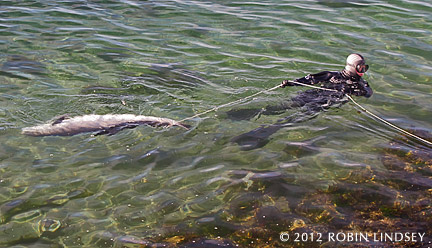
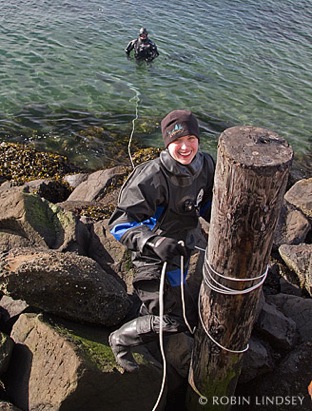
While the team from Cascadia Research (primary response team for cetaceans in South Puget Sound and the outer coast) and WDFW-MMI weighed the options with impending tide levels, it was determined the animal needed to be moved to an area with easier access than the steep rocks below the sea wall. Our investigator scaled the wall and towed the porpoise in the surf approximately 1/3 mile down to the sandy beach at Alki. Three volunteers assisted her in getting the estimated 150 lb. porpoise high up onto the beach, secured behind a large log overnight. Volunteers Christine and Raiana measured the porpoise at 5’8” while our responders documented the general condition with photographs. There were no obvious wounds evident in our preliminary examination of the porpoise.
To learn about harbor porpoise, click here.
UPDATE: 3/18 afternoon
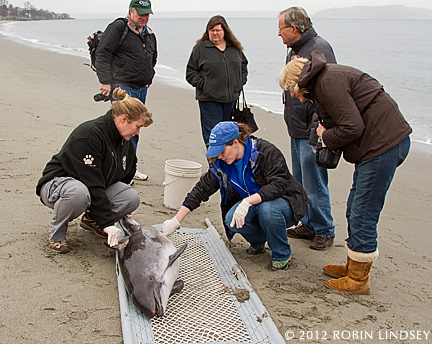
NECROPSY RESULTS UPDATE: 3/18 10:31 pm
Just in - The preliminary results of the necropsy reveal that the 3-5 year old female harbor porpoise suffered from a severe lung infection, with approximately 90% of each lung affected with pneumonia and markedly enlarged lymph nodes in the chest. The infection appeared to be systemic - not only causing damage to the chest , but had spread to the abdomen as well. Tissue samples will be sent to multiple laboratories to determine cause of the infection (fungal, bacterial, viral, parasitic or a combination of organisms). Final results can take a couple of months.
Harbor porpoise strands in Snohomish County
Nov/21/11 04:46 AM
Both our hotline and Edmonds Seal Sitters received calls about a “dolphin” washed up on a beach north of Edmonds. The animal turned out to be a harbor porpoise, likely a subadult in fairly good condition, with no obvious trauma or visible cause of death. Volunteers took photos, measurements, location information and secured the animal for pickup by a NOAA researcher for necropsy. Recovering the bodies of dead marine mammals is valuable to science and the environment. These necropsies allow us a window not only into the health of the population, but the health of the Sound as well.
Harbor porpoise, the smallest of the porpoise family at 5-5.5 feet long, are local to Puget Sound. They have a grey back and lighter to white belly. The dorsal, or top fin on their back, is a small triangle which differs from the more well-known dolphin with the classic curved dorsal fin. Washington’s largest and best known marine mammals, orcas, are actually the largest of the dolphin species with their distinctive tall, curved dorsal.
If you find a dead or live stranded dolphin or whale on the beach, do not touch or move it. Call the stranding network and keep people and dogs away for both their safety and the safety of the animal. To find your local stranding network and to learn more about strandings, click here.
Harbor porpoise, the smallest of the porpoise family at 5-5.5 feet long, are local to Puget Sound. They have a grey back and lighter to white belly. The dorsal, or top fin on their back, is a small triangle which differs from the more well-known dolphin with the classic curved dorsal fin. Washington’s largest and best known marine mammals, orcas, are actually the largest of the dolphin species with their distinctive tall, curved dorsal.
If you find a dead or live stranded dolphin or whale on the beach, do not touch or move it. Call the stranding network and keep people and dogs away for both their safety and the safety of the animal. To find your local stranding network and to learn more about strandings, click here.

